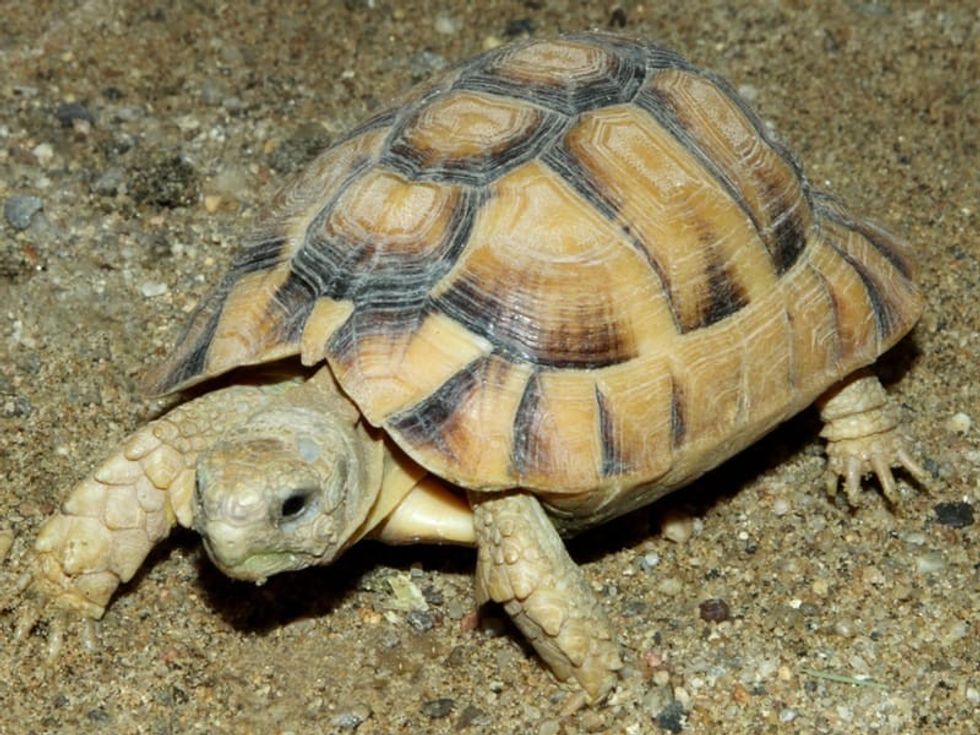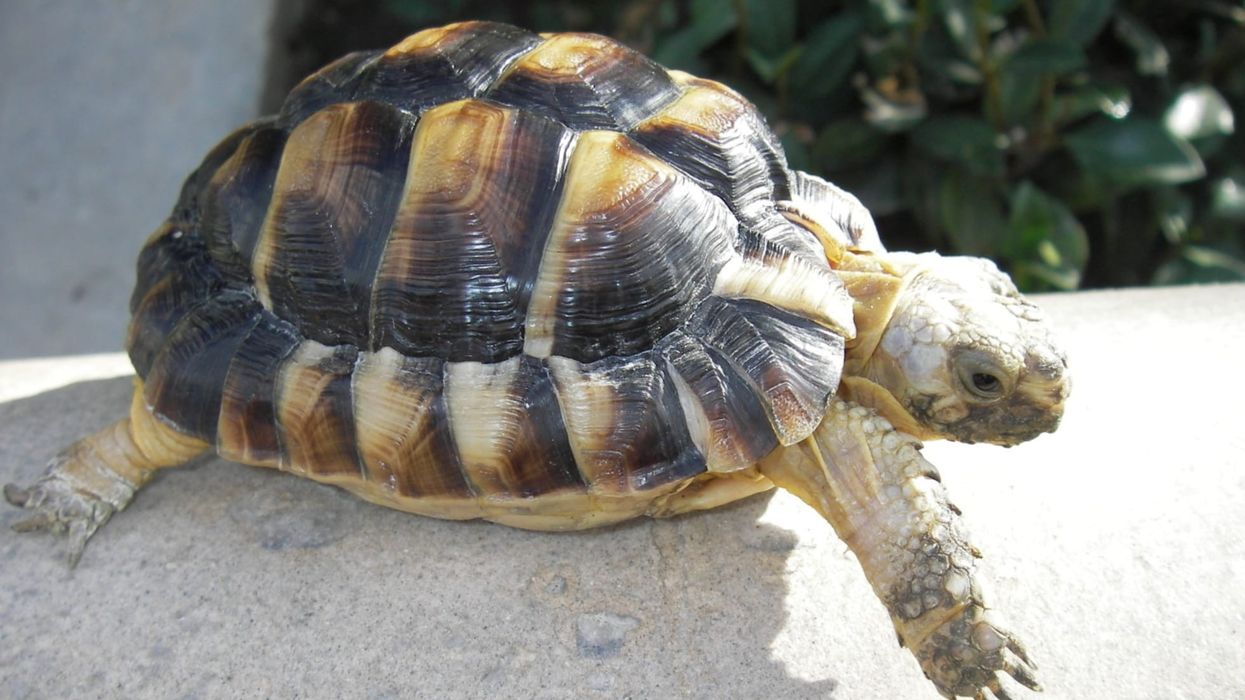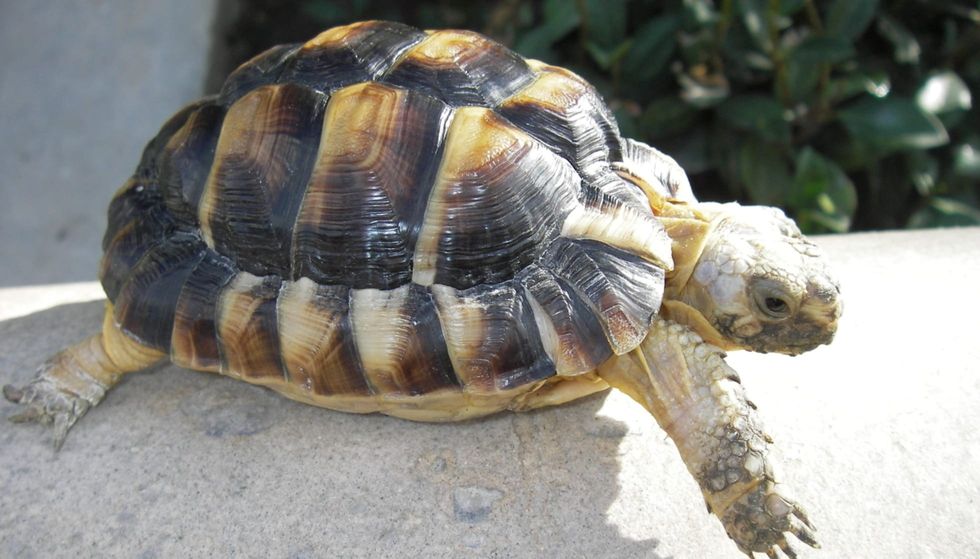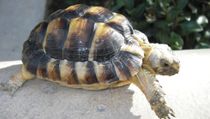Fun Egyptian Tortoise Facts For Kids

Have you ever wanted to keep a pet tortoise? Then Egyptian tortoises would be a great choice and they are also the world's second-smallest tortoise.
The Egyptian tortoise is an animal of the reptile type. Egyptian tortoises are also called Kleinmann's tortoise in honor of French stockbroker, Edouard Kleinmann who claimed the specimen in 1875. The other synonym, Testudo werneri is given in honor of Yehudah L. Werner, an Israel herpetologist.
Egyptian tortoises, otherwise called Leith's tortoise or Negev tortoise, were once widespread in Libya, Egypt, and Israel. But now, this species is nearly extinct in Egypt. The Egyptian tortoise shares a similar ancestor with the common tortoise (Greek tortoise) but has a slight variance regarding DNA sequence data.
The Egyptian tortoise has no subspecies, but the genus Testudo has five species, including this. They are Testudo grace (spur-thighed tortoise), Testudo marginata (Marginated tortoise), Testudo horsfieldii (Horsefield's tortoise), and Testudo hermanni Hermann's tortoise.
You can learn more about Egyptian tortoise care as you surf through our article. To explore more fascinating turtle species, check out African spurred tortoise facts and Mata mata turtle facts.
Egyptian Tortoise Interesting Facts
What type of animal is an Egyptian tortoise?
An Egyptian tortoise is a neck-hiding tortoise species of the family Testudinidae which is critically endangered.
What class of animal does an Egyptian tortoise belong to?
An Egyptian tortoise belongs to the class of Reptilia.
How many Egyptian tortoises are there in the world?
Egyptian tortoises were present in large numbers in Egypt, Israel, and Libya. But now, their population has decreased, and they are in near extinction in Egypt. Only ten tortoises were left in 2006. The scenario is similar in Libya, with a tiny population left, and most population destroyed due to human activity.
Illegal pet trade, hunting for traditional medicine, and habitat loss are the main reasons for population declination, and these may result in extinction if continued further. Israel, the Yemen plains, and the northwestern Negev are known to have the leftover population.
They remain threatened, though several protection laws and conservation programs have formed protected areas for these Testudo species. In Israel, the estimated population in 2010 was less than 2000 individuals.
Long back to three Testudo generations, the estimated population of the adult tortoise was nearly 55,000 to 56,000, while the present population is 7,500, which further decreased to 1000 adult tortoises now.
Where does an Egyptian tortoise live?
An Egyptian tortoise (Testudo Kleinmanni) lives in an arid habitat like desert and semi-desert regions.
What is an Egyptian tortoise's habitat?
An Egyptian tortoise's habitat is dry regions, woodlands, shrubby areas, sand wadis, coastal marshes generally with scattered rocks, compact sand, and gravel plains.
Who do Egyptian tortoises live with?
Egyptian tortoise is generally a calm and tolerant animal that can live solitary or in small groups with the same or some other non-aggressive species like the Agama lizard, girdled tailed lizard, and Egyptian spiny-tailed lizard. In captivity, the best stress-free ratio of male and female can be one male to two or three females.
It is not recommended to keep different species of tortoises as it may lead to inter-male aggression or hybridization.
How long does an Egyptian tortoise live?
An Egyptian tortoise (Testudo Kleinmanni) is expected to live nearly 28 years in captivity, but the maximum lifespan is much longer in the wild and can be nearly 70 to 100 years.
How do they reproduce?
Egyptian tortoises gain sexual maturity at five years of age and their breeding season in the wild is usually March. In captivity, they breed in April and between August and November.
As part of courtship, the adult male may chase the female and ram her. During mating, they make calls similar to the sound of a dove.
They lay a clutch of one to five eggs in shallow bowls under the bushes and sometimes vacant burrows. The incubation period lasts for nearly four to five months, after which the baby turtles hatch out from eggs in late summer or early autumn.
Captive breeding is also possible by keeping a male and a female together, and eggs are laid between January and July. The female turns active and searches for a suitable place to lay her eggs. Again, the substrate must be consistent and should not collapse, allowing her to dig the bowl patterns for the eggs.
What is their conservation status?
According to the IUCN Red List, the conservation status of the Egyptian tortoise (Kleinmann's tortoise) is Critically Endangered. This is because of some predators like desert monitor lizards and ravens that eat Egyptian tortoises and their eggs. Humans play a vital role in increasing their population through several laws and animal conservation programs to protect them.
Egyptian Tortoise Fun Facts
What do Egyptian tortoises look like?

Egyptian tortoises are the smallest turtles in Northern Hemisphere. They have sexual dimorphism, with female tortoises being more significant than males and males are slender than female tortoises and have longer tales.
The turtle shell covering essential organs has a high dome and variable colors ranging from ivory to pale gold, dull yellow, pink, or dark brown.
The uneven coloring that follows Gloger's rule helps them balance sunlight, letting the paler turtle sustain the hot desert temperatures. The shell color also helps them to camouflage in the desert.
The underside is light yellow with a dark triangle on each abdominal scute, and these scutes have are darker near the edges that fade as they age. Their limbs and head color range between pale ivory yellow and yellowish-brown.
The Negev tortoise, which is sometimes considered a different species, differs from our original species.
An Egyptian tortoise can be identified from the Negev tortoise by the pale dull yellow color of the shell, whereas the Negev tortoise will have gray, ivory, or rich golden color. In addition, the underside of the Egyptian tortoise will have two dark triangles on each scute which are missing in the Negev tortoise.
Baby Egyptian tortoise is slightly different from adults as far as color is concerned. The carapace of the hatchlings has brown spotted patterns which fade away after a few months.
How cute are they?
Egyptian tortoises are very cute and adorable animals, primarily due to their small size. Moreover, it is very interesting to watch the slow movements of this animal when kept in captivity.
How do they communicate?
Egyptian tortoises are generally calm and tolerant reptile species, and very less is known about how they communicate with each other. But, during mating, a male performs courtship by ramming the female, and both sexes, during copulation, make sounds similar to a pigeon.
How big is an Egyptian tortoise?
An Egyptian tortoise has a slight sexual dimorphism. The length of the male range between 3-4 in (8 - 10 cm) is relatively smaller than that of females whose length is 4-5 in (10-12 cm). Sometimes they can grow as big as 5.7 in (14.4 cm). It is two times smaller than a Greek tortoise.
How fast can an Egyptian tortoise move?
Generally, tortoises are slow-moving animals. Therefore, the exact speed of the Egyptian tortoise is not measured but it moves slightly faster than general turtle species that move at 0.12-0.31 mph(0.2 - 0.5 kph).
How much does an Egyptian tortoise weigh?
An Egyptian tortoise's weight range is between 5.5 - 12.5 oz (156 - 354 g).
What are the male and female names of the species?
These animals do not have any specific name for males and females and are called male tortoises and female tortoises.
What would you call a baby Egyptian tortoise?
An Egyptian tortoise baby has no specific name, but in general, it is called a hatchling.
What do they eat?
Egyptian tortoise diet includes a variety of greens like grass and leaf and blooms of plants. They diet on saltwort and sea lavender plants that grow in their native habitat.
In the wild, carrion and insects can be their food often. When kept in captive enclosures, the diet of these tortoises must be high in calcium and fiber and low in protein. Quality of food and feeding time is also essential.
A low-protein and high fiber greens and vegetable diet must be given at regular intervals. It is advisable to give Romine, endive, chicory, and other wild herbaceous plants like Brassica, clover, thistles, Plantago spp, and dandelion. The young can feed on the same diet as those of adult tortoises.
We can enrich their diet with vitamins and calcium by giving supplements once in a while. It is good to provide food and water in shallow bowls.
Are they poisonous?
The Egyptian tortoises are not poisonous at all, and many pet keepers enjoy these turtles as pets. But, these can sometimes be carriers of dangerous viruses such as Salmonella.
Therefore, it is always advisable to wash your hands after handling tortoises or after touching their environment. In addition, pregnant women, the elderly, young children, and people with less immunity must be very careful as they have a greater risk of illness by the Salmonella virus.
Would they make a good pet?
Egyptian tortoises are most popular among pet keepers because of their small and cute size. They make an excellent kept if the captivity enclosure reflects their natural habitat.
Their enclosure must be spacious enough and should be nearly two square meters. They are very active, especially the males walking around probing the surroundings during the spring and autumn.
Various substrates like coconut fiber, loam soil, or dry sand can be used as the enclosure base. The substrate should be moist during winter, but it has to be wet only in hiding caves in summer.
By moistening the substrate, we can maintain the required humidity. The enclosure should have a humidifier with a timer to increase humidity at night and in the morning.
Some structures in the enclosure can help the tortoise to rest and hide from mates. Successful breeding and raising of these tortoises in captivity can be achieved by regulating temperature and lighting.
Did you know...
Egyptian tortoise is the second smallest of all tortoise species, and the first smallest is South Africa's speckled padloper.
The Egyptian tortoise size is so tiny that 400 of these species are equal to one Galapagos tortoise size.
We can identify Egyptian tortoises from their remarkable high domed shell and small size.
Do Egyptian tortoises hibernate?
Egyptian tortoise does not hibernate, but they are less active during very hot or very cold weather. They forage outside only during midday in colder months. In warmer months, they are active only at dawn and dusk and spend the rest of the day in rodent burrows or under bushes.
Getting your own Egyptian tortoise
You can buy your Egyptian tortoise from various online stores. To get one tortoise you may have to pay nearly a thousand dollars. However, while buying, you must take care that you buy a healthy captive-bred tortoise from an experienced breeder.
Here at Kidadl, we have carefully created lots of interesting family-friendly animal facts for everyone to discover! Learn more about some other animals from our hawksbill sea turtle facts and Aldabra giant tortoise fun facts pages.
You can even occupy yourself at home by coloring in one of our free printable Egyptian tortoise coloring pages.
We Want Your Photos!
More for You
Bachelor of Science specializing in Human Anatomy

Joan AgieBachelor of Science specializing in Human Anatomy
With 3+ years of research and content writing experience across several niches, especially on education, technology, and business topics. Joan holds a Bachelor’s degree in Human Anatomy from the Federal University of Technology, Akure, Nigeria, and has worked as a researcher and writer for organizations across Nigeria, the US, the UK, and Germany. Joan enjoys meditation, watching movies, and learning new languages in her free time.
Bachelor of Arts specializing in Economics

Gowri RaoBachelor of Arts specializing in Economics
With a bachelor's degree in Economics from Krea University, Gowri is a highly skilled data analyst and an expert in regression and causation modeling. Her interests in economic trends, finance, and investment research complement her professional expertise. In addition to her professional pursuits, Gowri enjoys swimming, running, and playing the drums, and she is also a talented tutor.
Disclaimer
1) Kidadl is independent and to make our service free to you the reader we are supported by advertising. We hope you love our recommendations for products and services! What we suggest is selected independently by the Kidadl team. If you purchase using the Buy Now button we may earn a small commission. This does not influence our choices. Prices are correct and items are available at the time the article was published but we cannot guarantee that on the time of reading. Please note that Kidadl is a participant in the Amazon Services LLC Associates Program, an affiliate advertising program designed to provide a means for sites to earn advertising fees by advertising and linking to Amazon. We also link to other websites, but are not responsible for their content.
2) At Kidadl, we strive to recommend the very best activities and events. We will always aim to give you accurate information at the date of publication - however, information does change, so it’s important you do your own research, double-check and make the decision that is right for your family. We recognise that not all activities and ideas are appropriate for all children and families or in all circumstances. Our recommended activities are based on age but these are a guide. We recommend that these ideas are used as inspiration, that ideas are undertaken with appropriate adult supervision, and that each adult uses their own discretion and knowledge of their children to consider the safety and suitability. Kidadl cannot accept liability for the execution of these ideas, and parental supervision is advised at all times, as safety is paramount. Anyone using the information provided by Kidadl does so at their own risk and we can not accept liability if things go wrong.
3) Because we are an educational resource, we have quotes and facts about a range of historical and modern figures. We do not endorse the actions of or rhetoric of all the people included in these collections, but we think they are important for growing minds to learn about under the guidance of parents or guardians.







